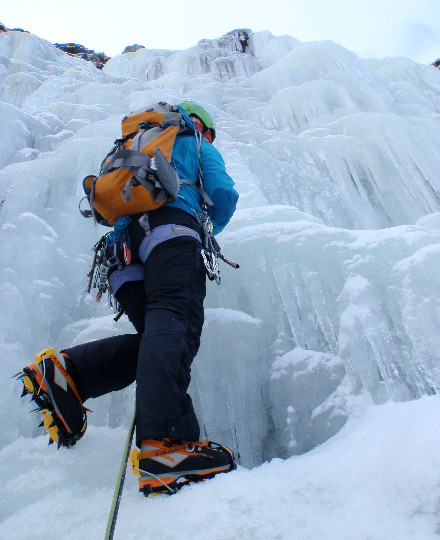Boots are probably the most important item of winter equipment. The type of boots you use should vary depending on the terrain and under foot conditions you expect to encounter.
It is not the case that one pair of boots will be good for every situation you might find yourself in in the mountains. As an extreme example, a summer walk in the Pentland Hills on dry, grassy terrain will require very different footwear to ascending a Munro in winter conditions.
You need to choose your footwear carefully, as secure footwork is essential for safe mountain travel. To put this into context, around one quarter of mountain rescue incidents are as a direct result of someone taking a slip in the wrong place and becoming injured.
In summer conditions a flexible fabric or leather boot with a Vibram sole is recommended. Some folk will be happy to use approach shoes, but remember they will have little or no ankle support.

Wearing rigid-soled boots for ice climbing. (The crampons are C2)
In winter, however, underfoot conditions can be very challenging. Stiff-soled boots provide the security you need, with rigid side edges and toes for creating secure footsteps and holding a crampon. On slopes which are of sufficient angle for a slip to become a fall or an uncontrollable slide, stiff soled boots are more secure because the side edges and toes are more effective at creating secure footsteps.
To make the purchase of the correct type of boot easier, a ‘rating’ system has been established, and all good outdoor retailers will use this system.
From the storeroom at Glenmore Lodge: advice on the differences between boots and how to choose the right boot for your activity - and how to choose the right crampons to fit.
For professional advice on what brand and type of boot to purchase for your chosen activity check with your local professional outdoor retailer such as Tiso, Cotswold, Nevisport or Craigdon Mountain Sports.